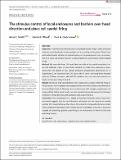Files in this item
The stimulus control of local enclosures and barriers over head direction and place cell spatial firing
Item metadata
| dc.contributor.author | Smith, Anna | |
| dc.contributor.author | Wood, Emma | |
| dc.contributor.author | Dudchenko, Paul | |
| dc.date.accessioned | 2021-02-23T11:30:11Z | |
| dc.date.available | 2021-02-23T11:30:11Z | |
| dc.date.issued | 2021-05-01 | |
| dc.identifier | 272449747 | |
| dc.identifier | 567c735b-da88-426d-85e0-3e4f77532e84 | |
| dc.identifier | 85101006926 | |
| dc.identifier | 000619584300001 | |
| dc.identifier.citation | Smith , A , Wood , E & Dudchenko , P 2021 , ' The stimulus control of local enclosures and barriers over head direction and place cell spatial firing ' , Brain and Behaviour , vol. 11 , no. 5 , e02070 . https://doi.org/10.1002/brb3.2070 | en |
| dc.identifier.issn | 2162-3279 | |
| dc.identifier.other | ORCID: /0000-0003-1438-2663/work/89628340 | |
| dc.identifier.uri | https://hdl.handle.net/10023/21487 | |
| dc.description | Funding: This research was supported by a grant to P.A.D. and E.R.W. from the Biotechnology and Biological Sciences Research Council (BB/P002455/1). | en |
| dc.description.abstract | Objective Head direction cell and place cell spatially tuned firing is often anchored to salient visual landmarks on the periphery of a recording environment. What is less well understood is whether structural features of an environment, such as orientation of a maze sub-compartment or a polarising barrier, can likewise control spatial firing. Method We recorded from 54 head direction cells in the medial entorhinal cortex and subicular region of male Lister Hooded rats while they explored an apparatus with four parallel or four radially-arranged compartments (Experiment 1). In Experiment 2, we recorded from 130 place cells (in Lister- and Long-Evans Hooded rats) and 30 head direction cells with 90° rotations of a cue card and a barrier in a single environment (Experiment 2). Results We found that head direction cells maintained a similar preferred firing direction across four separate maze compartments even when these faced different directions (Experiment 1). However, in an environment with a single compartment, we observed that both a barrier and a cue card exerted comparable amounts of stimulus control over head direction cells and place cells (Experiment 2). Conclusion The maintenance of a stable directional orientation across maze compartments suggests that the head direction cell system has the capacity to provide a global directional reference that allows the animal to distinguish otherwise similar maze compartments based on the compartment’s orientation. A barrier is, however, capable of controlling spatially tuned firing in an environment in which it is the sole polarising feature. | |
| dc.format.extent | 14 | |
| dc.format.extent | 1427087 | |
| dc.language.iso | eng | |
| dc.relation.ispartof | Brain and Behaviour | en |
| dc.subject | Head direction cells | en |
| dc.subject | Hippocampus | en |
| dc.subject | Navigation | en |
| dc.subject | Place cells | en |
| dc.subject | Spatial cognition | en |
| dc.subject | BF Psychology | en |
| dc.subject | RC0321 Neuroscience. Biological psychiatry. Neuropsychiatry | en |
| dc.subject | NDAS | en |
| dc.subject | MCC | en |
| dc.subject.lcc | BF | en |
| dc.subject.lcc | RC0321 | en |
| dc.title | The stimulus control of local enclosures and barriers over head direction and place cell spatial firing | en |
| dc.type | Journal article | en |
| dc.contributor.institution | University of St Andrews. School of Psychology and Neuroscience | en |
| dc.identifier.doi | https://doi.org/10.1002/brb3.2070 | |
| dc.description.status | Peer reviewed | en |
This item appears in the following Collection(s)
Items in the St Andrews Research Repository are protected by copyright, with all rights reserved, unless otherwise indicated.

